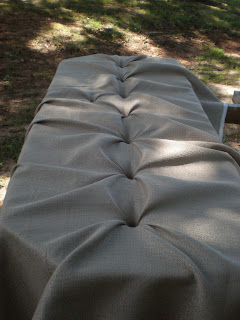I decided to use some of the scrapes in darker colors to make a small "test" rug. I was able to finish it in a few days, just working on it an hour or so after work. It wasn't perfect but I loved it anyways. I learned a few tricks along the way to use on the next one and make it better.
Not too bad for a first attempt. This rug is now in the bedroom of the tiny house and fits perfectly in the space.
I have had requests for an instructional post so I'm going to attempt it. This will be for an oval rug. I've not yet done round or rectangular ones. I tried to take pictures of the steps and hopefully you all can follow it easily. Here goes!!
Decide how big you want your rug to be lengthwise. My rug is going to be 5 foot. You will need to make your beginning center half the length of the rug, in this case 30 inches.
First, you need to make your "needle" out of something handy. If you have a toothbrush with a hole in the end, perfect. Most of the new ones don't have that hole, so I took some scrape copper wire I had and bent it into shape. You could also use an old wire coat hanger to do this.
Here's my wonderfully crafted needle. I just bent the wire in a somewhat oval shape with a wider end for the material. I then wrapped the ends with duct tape. Easy peasy!
I had completed a little more than half my rug when I decided to do this post so bear with me as I try to explain how to start.
You need to rip your material into strips about 1 to 2 inches wide. If you are using cotton, you can make a small cut at the top of your material and then just rip it the rest of the way. It should stay pretty consistent but you will get threads hanging off. I just pull them off when they get in my way.
Take two pieces of your material and tie them together. There is a nifty way to join them without big knots. You need to make a small hole in the ends of all your strips for joining. I used two different colors to show this to you.
Take the first strip(yellow) and feed it through the hole of the second(green). Then take the tail of the first strip and feed it through the hole at the strips head. Follow me so far?
Just give it a pull and it will tighten into a nice small join. This will keep knots out of your rug.
One strand of material (green) will be your "filler" fabric. This will be what you loop around. I use a safety pin through my slip knot and attach it to a pillow or something to hold the material tight when I'm making my center. Your working strip (yellow) is what you will be doing the knotting with. You start with it on your left hand side, cross it over the green one, go under the green one and cross back over the yellow one. Pull the yellow one tight to make the first knot.
My pictures of how it should look didn't come out clearly so here's an example of how the knots should look. You don't have to pull them to tight as you will be going back through them later.
Once you get to the end of your length, you need to turn your piece so that the working strip (yellow) is now on your right side and the filler strip(green) is on the left. You will then pull the filler tail down the left side of the row you just finished. Pull your working strip around as well. You are going to be weaving the working strip into that row you just finished. Again no great beginning pics.
Imagine that the white strip I'm touching is the first knot row you made. The green is your filler strip and the white & green is your working strip.
Feed your needle with your working strip on it through the hole and under the green filler strip, then back over the working strip and pull into the finished knot.
At this point, I didn't take a bunch of pictures so I'm going to link a blog post with lots of good YouTube step by step videos on it.
It took me a little over two weeks to complete my rug. I was only able to get an hour or two a night in during the week. It's a little over 5 foot long and a little over 3 foot wide. When it was finished, I sewed a few strips of rubber shelf liner to the bottom of the rug. This keeps it from slipping around on the floor.
As you can see, it fits perfectly in my kitchen space! I was extremely happy with how it turned out and hope the next one is even better. I had a lot of fun working on this. :)

























